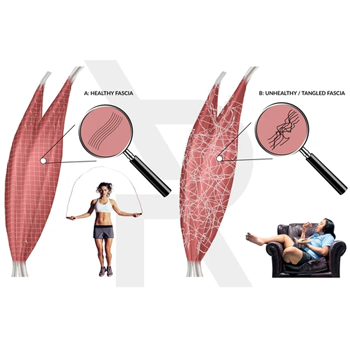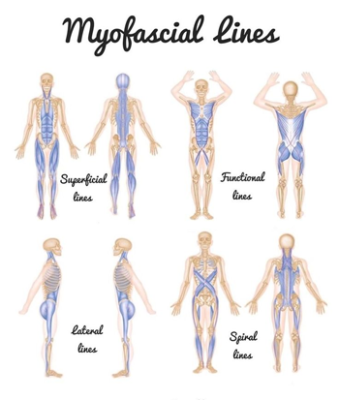Fascia.
What is Fascia?
Why it is so important?
How does it work?
How Thai Massage can help to improve fascia mobility?
Fascia (from Latin: “band”) is a band or sheet of connective tissue, mainly made of collagen, that seats below the skin and attaches to, stabilizes, encloses, and separates muscles and other internal organs.

Firstly, fascia can be classified by layers: Superficial; Deep; Visceral or parietal or by its function and anatomical location.
Like as per other body parts, such as ligaments, aponeurosis, and tendons fascia is made from fibrous connective tissues.
In addition, these connective tissues contain bundles of collagen fibres oriented in webby patterns, parallel to the direction of pull.
About collagen fibres, they are produced from fibroblast, contained within the fascia.
In conclusion, fascia differs from other body components such as ligaments and tendons.
This is because ligaments hold bonds together and the tendon attaches the muscle to the bonds.
Going ahead we can define F. based on its location and
| Superficial F. | This is found just below the last skin layer, subcutis, in most regions of the body, blending with the reticular layer of the dermis. |
| Muscular F. | Defined as the fibrous layer seating around the muscle, or other body parts such as nerves, bonds. |
| Visceral or parietal F. | This type of structure suspends the organs with their cavities and wraps them in layers of connective tissue membranes. |
In regards to the functionality of the F., we look in too the ability of this tissue to allow the muscle to move freely.
If this post is talking to you, and you are in need of a massage, book your next session by clicking here.
So let’s imagine this really thick web, seating between the skin and the muscle and around the muscle too.
If the web is overconnected, that means is tight, the muscle would find difficulties in moving and sliding.
The same would happen for tendons and organs that need to function by being able to move freely.
For example, it does often happen to see customers that when asked to flex the shoulder, as they bring the arm over the head, past the 90° point, it is noticeable a dragging in the fascia along the anterior and or posterior and or lateral thoracic area.
The person itself, unless get told to feel what happens in the thoracic area, would hardly be aware of any restrictions along the thoracic area.
Said so, we can now open a pandora Jar and talk about the fascia lines.

Fascia lines connect the body side to side in the long, for the horizontal and diagonal directions.
As per the example, we have an F line that travels from the foot to the head.
Indeed this F line starts from the Fibularis M, going up for the IT Band, in too the TFL, Obliquos Abdominal muscles, opposite Serratus Anterior, Rhomboids, and Finally to Splenius Capitis.
As per result, someone that suffers from flat feet, and so has Fibularis M, under constant pulling force, may experience shoulder pain on the same side of the body because of Fascia restrictions.
But the are more F. lines than the diagonal ones.
In fact, we got a Superficial F. line, Functional F. line and Lateral Lines.
So, lastly, how Thai Massage can help?
Thai Massage can help with stretching the fascia by applying a force on the skin in the direction where the restriction is.
Is enough to check in which direction the skin feels tight, and that’s the direction in too we want to apply a stroke with a pulling force, strong enough that the client does actually feel a stretch.
At Melbourne Thai Treatment I use techniques of work like MFTT and or Cupping and static/dynamic stretching.
In regards to cupping add MFTT are a technique of work that I did learn at RMIT along with my study for the Diploma in Remedial Massage.
The static/dynamic stretch, indeed, is part of the techniques used along with the Thai Massage.
In conclusion to this blog post, I then would like to invite you to see this video from Dr Gil Hedley, that dives in too the magnificence of Fascia.